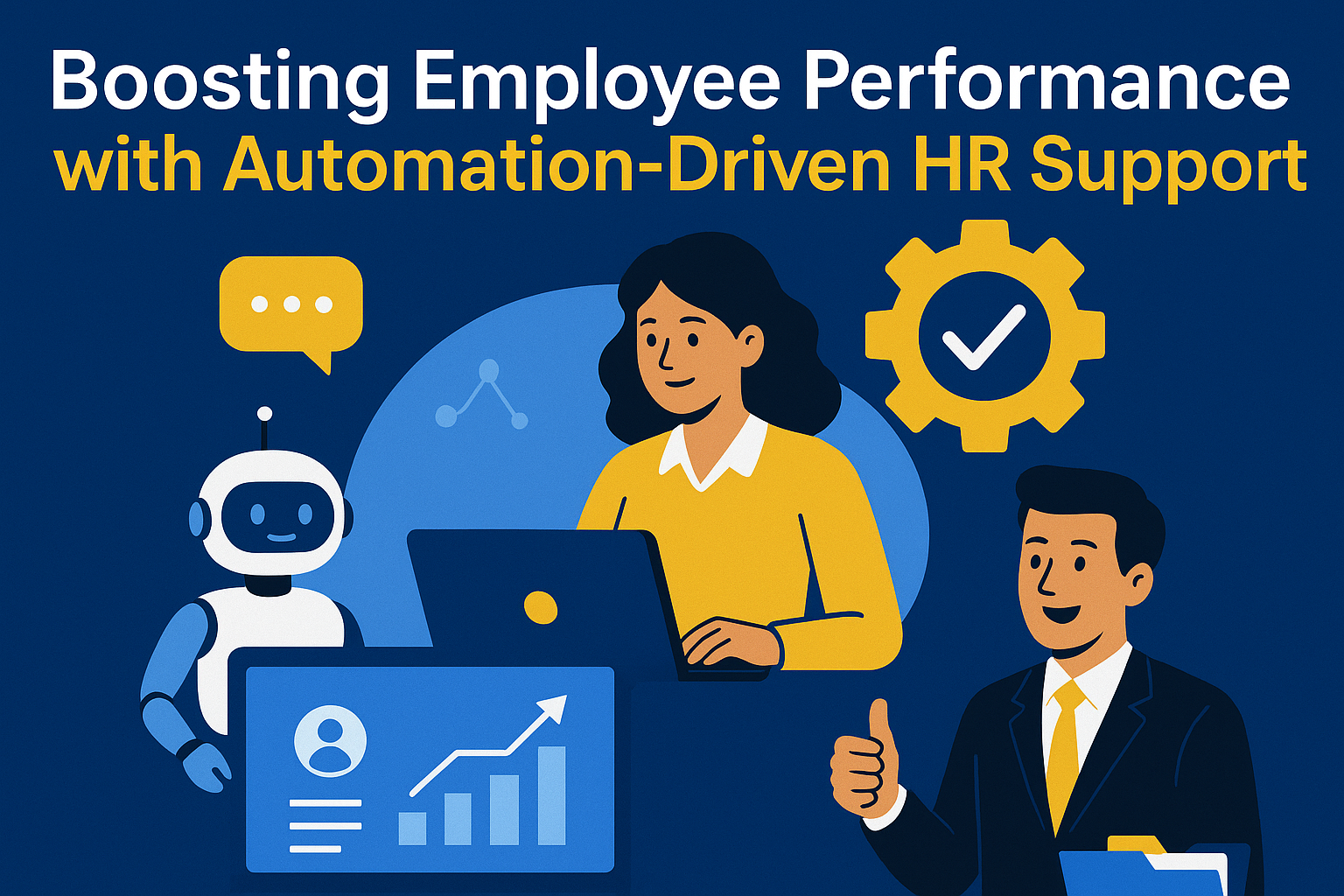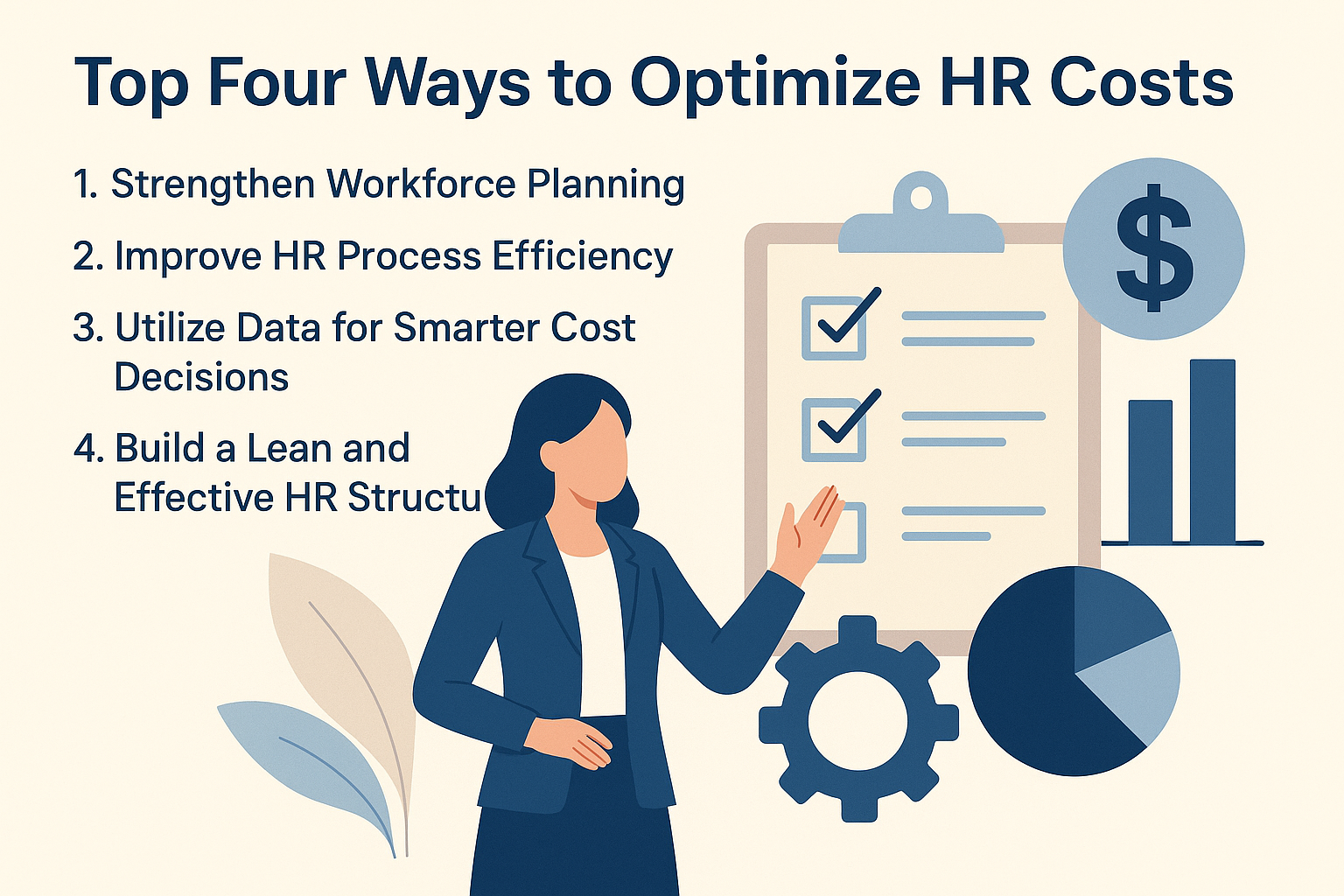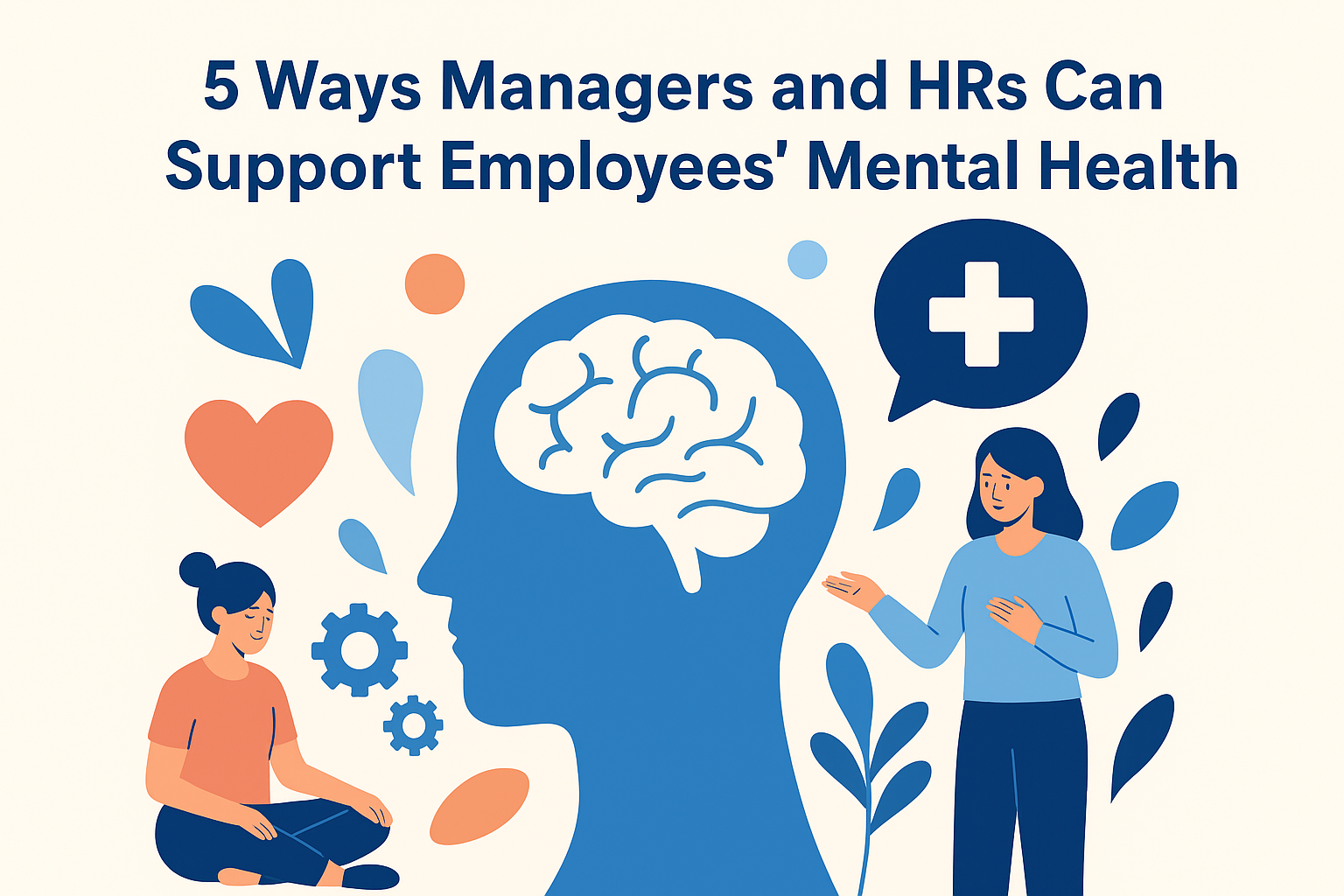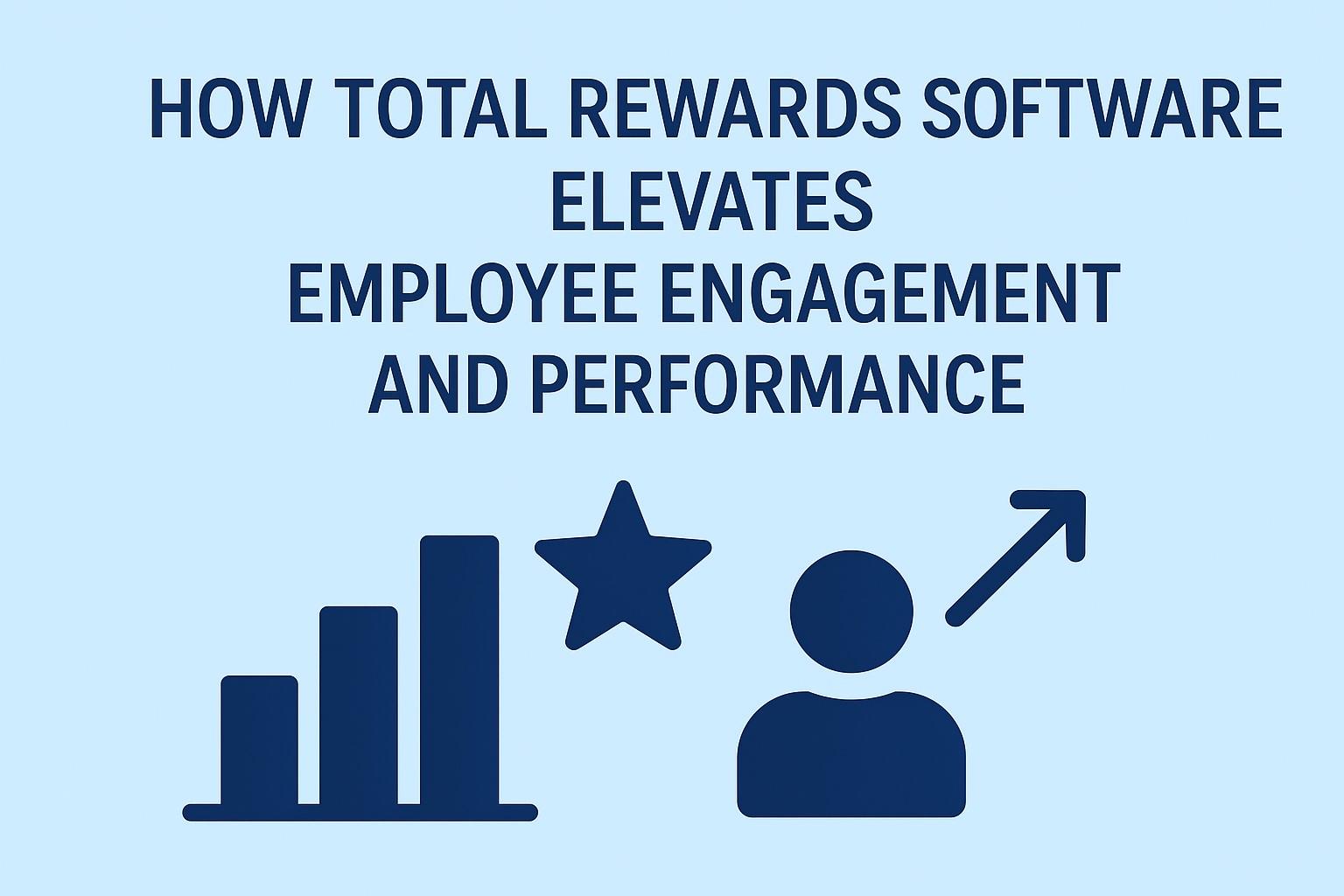Recent Updates
-
Creating Streamlined Processes through Automation-Driven HR Support
Automation-Driven HR Support is rapidly reshaping how organizations elevate employee performance. As workplaces grow more digital and fast paced, automation enables HR teams to streamline operations, improve decision making, and create seamless employee experiences that directly boost productivity.
Understanding Automation-Driven HR Support
Automation in HR simplifies repetitive tasks, reduces manual workloads, and creates space for strategic decision making. With intelligent systems handling scheduling, onboarding assistance, query responses, and workflow routing, HR teams can focus on initiatives that contribute to long-term employee growth. This shift not only accelerates internal processes but also creates a more responsive and efficient support environment.
Enhancing Employee Performance Through Automation
Performance improvement thrives on clarity, timely feedback, and access to the right tools. Automation enables real-time performance tracking, automated insights, and personalized skill development opportunities. These systems allow employees to stay aligned with goals while receiving guidance exactly when needed. Enhanced transparency and reduced delays lead to higher engagement, more confidence, and better results across teams.
Building a Future-Ready HR Ecosystem
For organizations aiming to strengthen their workforce, building an ecosystem that integrates automation into everyday HR operations is essential. Automated workflows support employees throughout their lifecycle—from onboarding to continuous development—ensuring consistent experiences and reducing friction. Smart HR systems also promote accuracy, compliance, and speed, which collectively drive stronger organizational performance.
The Strategic Role of Automation in Workforce Success
Beyond operational efficiency, automation empowers HR leaders to make strategic workforce decisions. Predictive insights, automated reporting, and streamlined communication channels help HR identify performance gaps early, design targeted interventions, and elevate organizational culture. As automation grows more advanced, its role evolves from support to strategic leadership.
For More Info: https://hrtechcube.com/automation-support-future-of-employee-performance/
Conclusion
Automation-Driven HR Support is a powerful catalyst for improved employee performance. By eliminating operational bottlenecks, guiding employees with intelligent insights, and building scalable HR systems, organizations create stronger, more agile, and future-ready workforces.Creating Streamlined Processes through Automation-Driven HR Support Automation-Driven HR Support is rapidly reshaping how organizations elevate employee performance. As workplaces grow more digital and fast paced, automation enables HR teams to streamline operations, improve decision making, and create seamless employee experiences that directly boost productivity. Understanding Automation-Driven HR Support Automation in HR simplifies repetitive tasks, reduces manual workloads, and creates space for strategic decision making. With intelligent systems handling scheduling, onboarding assistance, query responses, and workflow routing, HR teams can focus on initiatives that contribute to long-term employee growth. This shift not only accelerates internal processes but also creates a more responsive and efficient support environment. Enhancing Employee Performance Through Automation Performance improvement thrives on clarity, timely feedback, and access to the right tools. Automation enables real-time performance tracking, automated insights, and personalized skill development opportunities. These systems allow employees to stay aligned with goals while receiving guidance exactly when needed. Enhanced transparency and reduced delays lead to higher engagement, more confidence, and better results across teams. Building a Future-Ready HR Ecosystem For organizations aiming to strengthen their workforce, building an ecosystem that integrates automation into everyday HR operations is essential. Automated workflows support employees throughout their lifecycle—from onboarding to continuous development—ensuring consistent experiences and reducing friction. Smart HR systems also promote accuracy, compliance, and speed, which collectively drive stronger organizational performance. The Strategic Role of Automation in Workforce Success Beyond operational efficiency, automation empowers HR leaders to make strategic workforce decisions. Predictive insights, automated reporting, and streamlined communication channels help HR identify performance gaps early, design targeted interventions, and elevate organizational culture. As automation grows more advanced, its role evolves from support to strategic leadership. For More Info: https://hrtechcube.com/automation-support-future-of-employee-performance/ Conclusion Automation-Driven HR Support is a powerful catalyst for improved employee performance. By eliminating operational bottlenecks, guiding employees with intelligent insights, and building scalable HR systems, organizations create stronger, more agile, and future-ready workforces.0 Comments 0 Shares 8 ViewsPlease log in to like, share and comment! -
Transforming HR Functions in Financial Institutions with High-Impact HR Interventions
Financial institutions operate in a fast-evolving environment shaped by regulatory expectations technological advancements and growing competition. To stay resilient these organizations are redefining how HR functions support business goals. Modern transformation focuses on agility data-based decisions workforce capability and strategic alignment.
Table of Contents
The Evolving Role of HR Functions in Financial Institutions
Driving Workforce Agility Through Strategic HR
Digital HR Enablement and Technology Integration
Building Leadership and Future-Ready Talent
Strengthening Compliance and Risk-Aligned People Practices
Conclusion
1. The Evolving Role of HR Functions in Financial Institutions
HR functions in financial institutions are shifting from traditional administrative operations to strategic business partners. The focus is on talent acquisition cultural development performance management and long-term workforce design that aligns with business growth priorities. The transformation enables HR to support innovation risk management and competitive advantage.
2. Driving Workforce Agility Through Strategic HR
Agility is a core requirement for modern financial institutions. Strategic HR supports workforce agility by enabling flexible work structures capability-based roles and fast reskilling. With rapid industry changes HR ensures employees adapt quickly to new tools regulatory updates and market shifts. A strong talent mobility framework helps organizations place employees where they can create the most value.
3. Digital HR Enablement and Technology Integration
Digital transformation is central to the evolution of HR functions in financial institutions. Technology adoption includes AI-powered recruitment analytics-driven decision making mobile-first employee experience tools and automated compliance workflows. By integrating these tools HR reduces manual load and builds more transparent data-driven systems that improve employee engagement and organizational efficiency.
4. Building Leadership and Future-Ready Talent
As financial institutions expand into digital financial services HR plays a key role in developing future-ready leaders. This includes leadership development programs digital literacy initiatives behavioral training and succession planning. Strong leaders help institutions navigate regulatory complexity customer expectations and technological disruptions.
5. Strengthening Compliance and Risk-Aligned People Practices
Regulatory compliance remains a defining responsibility for financial institutions. HR ensures adherence through robust governance frameworks standardized processes transparent reporting and continuous employee training. Proper documentation and compliance-aligned HR practices reduce institutional risk and enhance operational resilience.
For More Info: https://hrtechcube.com/strategic-hr-transformation-financial-institutions/
Conclusion
HR functions in financial institutions are becoming strategic engines that drive operational excellence talent strength and digital growth. By embracing innovation improving workforce capability and aligning with regulatory needs HR empowers financial organizations to stay competitive and sustainable in an increasingly dynamic environment.Transforming HR Functions in Financial Institutions with High-Impact HR Interventions Financial institutions operate in a fast-evolving environment shaped by regulatory expectations technological advancements and growing competition. To stay resilient these organizations are redefining how HR functions support business goals. Modern transformation focuses on agility data-based decisions workforce capability and strategic alignment. Table of Contents The Evolving Role of HR Functions in Financial Institutions Driving Workforce Agility Through Strategic HR Digital HR Enablement and Technology Integration Building Leadership and Future-Ready Talent Strengthening Compliance and Risk-Aligned People Practices Conclusion 1. The Evolving Role of HR Functions in Financial Institutions HR functions in financial institutions are shifting from traditional administrative operations to strategic business partners. The focus is on talent acquisition cultural development performance management and long-term workforce design that aligns with business growth priorities. The transformation enables HR to support innovation risk management and competitive advantage. 2. Driving Workforce Agility Through Strategic HR Agility is a core requirement for modern financial institutions. Strategic HR supports workforce agility by enabling flexible work structures capability-based roles and fast reskilling. With rapid industry changes HR ensures employees adapt quickly to new tools regulatory updates and market shifts. A strong talent mobility framework helps organizations place employees where they can create the most value. 3. Digital HR Enablement and Technology Integration Digital transformation is central to the evolution of HR functions in financial institutions. Technology adoption includes AI-powered recruitment analytics-driven decision making mobile-first employee experience tools and automated compliance workflows. By integrating these tools HR reduces manual load and builds more transparent data-driven systems that improve employee engagement and organizational efficiency. 4. Building Leadership and Future-Ready Talent As financial institutions expand into digital financial services HR plays a key role in developing future-ready leaders. This includes leadership development programs digital literacy initiatives behavioral training and succession planning. Strong leaders help institutions navigate regulatory complexity customer expectations and technological disruptions. 5. Strengthening Compliance and Risk-Aligned People Practices Regulatory compliance remains a defining responsibility for financial institutions. HR ensures adherence through robust governance frameworks standardized processes transparent reporting and continuous employee training. Proper documentation and compliance-aligned HR practices reduce institutional risk and enhance operational resilience. For More Info: https://hrtechcube.com/strategic-hr-transformation-financial-institutions/ Conclusion HR functions in financial institutions are becoming strategic engines that drive operational excellence talent strength and digital growth. By embracing innovation improving workforce capability and aligning with regulatory needs HR empowers financial organizations to stay competitive and sustainable in an increasingly dynamic environment. HRTECHCUBE.COMTransforming HR Functions in Financial Institutions with Strategic Support at the CoreReinventing HR in finance isn’t optional—it’s a growth strategy with compliance baked in.0 Comments 0 Shares 17 Views
HRTECHCUBE.COMTransforming HR Functions in Financial Institutions with Strategic Support at the CoreReinventing HR in finance isn’t optional—it’s a growth strategy with compliance baked in.0 Comments 0 Shares 17 Views -
Why Modern HR Depends on Four Ways to Optimize HR Costs
Optimizing HR costs has become a priority for businesses aiming to balance efficiency with employee experience. By focusing on practical strategies that strengthen workforce management and reduce unnecessary expenses, companies can build a more agile and cost-effective HR ecosystem.
Table of Contents
Strengthen Workforce Planning
Improve HR Process Efficiency
Utilize Data for Smarter Cost Decisions
Build a Lean and Effective HR Structure
1. Strengthen Workforce Planning
A well-planned workforce structure helps remove overlaps in responsibility and eliminates unnecessary hiring cycles. When organizations invest time in understanding skill gaps and workforce demand, they can deploy employees more effectively and reduce unplanned staffing costs. This approach ensures better resource allocation across teams while keeping budget limits in mind.
2. Improve HR Process Efficiency
Streamlining HR processes reduces the time and effort spent on repetitive administrative tasks. When workflows such as onboarding, document management, and attendance tracking become smoother, HR teams can focus on strategic initiatives instead of manual work. This reduces operational delays and overall HR-related expenses while improving the employee experience.
3. Utilize Data for Smarter Cost Decisions
Data-driven decision-making helps organizations discover hidden cost patterns and identify areas that require improvement. By analyzing employee performance, hiring trends, and payroll distribution, HR leaders can make informed choices that minimize wasteful spending. Data insights also support planning for future needs, ensuring stable long-term HR cost management.
4. Build a Lean and Effective HR Structure
A lean HR structure encourages responsibility clarity and eliminates resource duplication. When roles are defined clearly, teams operate more efficiently, leading to lower administrative effort and reduced staffing costs. This structure also helps organizations stay prepared for market changes while maintaining a strong internal workforce engine.
For More Info: https://hrtechcube.com/top-4-ways-to-optimize-hr-costs/
Conclusion
Managing HR costs effectively requires a combination of strategic planning, smart resource allocation, and continuous improvement. Organizations that prioritize workforce efficiency and process optimization can achieve sustainable cost control without compromising employee satisfaction. By using these four ways to optimize HR costs, businesses create a strong foundation for long-term growth.
Related News/ Articles Link:
https://hrtechcube.com/roi-employee-wellness-2025/
https://hrtechcube.com/ai-driven-feedback-solutions/
https://hrtechcube.com/rethinking-talent-strategies-workplace-2025/
https://hrtechcube.com/skills-based-hiring-2025/Why Modern HR Depends on Four Ways to Optimize HR Costs Optimizing HR costs has become a priority for businesses aiming to balance efficiency with employee experience. By focusing on practical strategies that strengthen workforce management and reduce unnecessary expenses, companies can build a more agile and cost-effective HR ecosystem. Table of Contents Strengthen Workforce Planning Improve HR Process Efficiency Utilize Data for Smarter Cost Decisions Build a Lean and Effective HR Structure 1. Strengthen Workforce Planning A well-planned workforce structure helps remove overlaps in responsibility and eliminates unnecessary hiring cycles. When organizations invest time in understanding skill gaps and workforce demand, they can deploy employees more effectively and reduce unplanned staffing costs. This approach ensures better resource allocation across teams while keeping budget limits in mind. 2. Improve HR Process Efficiency Streamlining HR processes reduces the time and effort spent on repetitive administrative tasks. When workflows such as onboarding, document management, and attendance tracking become smoother, HR teams can focus on strategic initiatives instead of manual work. This reduces operational delays and overall HR-related expenses while improving the employee experience. 3. Utilize Data for Smarter Cost Decisions Data-driven decision-making helps organizations discover hidden cost patterns and identify areas that require improvement. By analyzing employee performance, hiring trends, and payroll distribution, HR leaders can make informed choices that minimize wasteful spending. Data insights also support planning for future needs, ensuring stable long-term HR cost management. 4. Build a Lean and Effective HR Structure A lean HR structure encourages responsibility clarity and eliminates resource duplication. When roles are defined clearly, teams operate more efficiently, leading to lower administrative effort and reduced staffing costs. This structure also helps organizations stay prepared for market changes while maintaining a strong internal workforce engine. For More Info: https://hrtechcube.com/top-4-ways-to-optimize-hr-costs/ Conclusion Managing HR costs effectively requires a combination of strategic planning, smart resource allocation, and continuous improvement. Organizations that prioritize workforce efficiency and process optimization can achieve sustainable cost control without compromising employee satisfaction. By using these four ways to optimize HR costs, businesses create a strong foundation for long-term growth. Related News/ Articles Link: https://hrtechcube.com/roi-employee-wellness-2025/ https://hrtechcube.com/ai-driven-feedback-solutions/ https://hrtechcube.com/rethinking-talent-strategies-workplace-2025/ https://hrtechcube.com/skills-based-hiring-2025/0 Comments 0 Shares 496 Views -
Change Management Foundations for HR Technology Evolution
Implementing new HR systems often creates uncertainty, but with structured planning and clear communication, organizations can guide employees through change with confidence. Effective Change Management HR Technology ensures smoother adoption, stronger engagement, and long-term operational success.
Why Change Management Matters in HR Technology
HR technology impacts daily operations, from payroll to performance management. When change is not managed well, employees may resist, productivity may drop, and the organization may fail to realize the benefits of its investment. Change management helps align people, processes, and systems, ensuring every user understands the purpose and value of the new tools.
Core Strategies for HR Technology Change Management
Create a Clear and Motivating Vision
Employees need clarity on why new technology is being introduced. Explaining expected improvements such as simplified workflows or faster approvals helps build trust.
Engage Stakeholders Early
Involving managers, HR partners, and end-users early in the transition encourages ownership. When people feel heard, they are more willing to support the change.
Provide Role-Based Training
A one-size-fits-all approach rarely works. Tailored training ensures each employee receives the exact knowledge and skills needed for their responsibilities.
Communicate Frequently and Honestly
Transparent communication reduces anxiety. Sharing updates on timelines, expected challenges, and progress keeps everyone aligned.
Introduce Technology in Phases
A gradual rollout allows teams to adapt step-by-step, minimizing disruptions and giving HR time to address feedback during each phase.
Measure Adoption and Adjust
Tracking how employees interact with new tools helps identify where additional support or simplified processes may be required.
Strengthening Adoption Through HR Technology Tools
Many HR platforms include built-in features that support the change process. Communication modules help share updates instantly. Learning tools guide employees through step-by-step tutorials. Analytics dashboards help HR teams view adoption patterns and identify where extra training may be needed.
Using technology to support the transition makes change smoother, more organized, and easier to sustain.
Building a Supportive Culture for Sustainable Change
Successful change depends on culture. When leaders model usage, encourage experimentation, and recognize employee progress, they create an environment where people feel comfortable embracing new systems. Celebrating early adopters and reinforcing positive behavior strengthens confidence across the workforce.
A flexible, learning-driven culture ensures that employees stay open to future HR technology enhancements as well.
For More Info: https://hrtechcube.com/change-management-strategies-for-hr/
Conclusion
Change Management HR Technology is most successful when organizations blend clear communication, structured planning, and employee-centered support. By engaging stakeholders early, providing practical training, and nurturing a culture that embraces innovation, HR teams can ensure that new tools deliver meaningful impact. When change is managed thoughtfully, HR technology becomes a powerful catalyst for efficiency, collaboration, and long-term organizational growth.Change Management Foundations for HR Technology Evolution Implementing new HR systems often creates uncertainty, but with structured planning and clear communication, organizations can guide employees through change with confidence. Effective Change Management HR Technology ensures smoother adoption, stronger engagement, and long-term operational success. Why Change Management Matters in HR Technology HR technology impacts daily operations, from payroll to performance management. When change is not managed well, employees may resist, productivity may drop, and the organization may fail to realize the benefits of its investment. Change management helps align people, processes, and systems, ensuring every user understands the purpose and value of the new tools. Core Strategies for HR Technology Change Management Create a Clear and Motivating Vision Employees need clarity on why new technology is being introduced. Explaining expected improvements such as simplified workflows or faster approvals helps build trust. Engage Stakeholders Early Involving managers, HR partners, and end-users early in the transition encourages ownership. When people feel heard, they are more willing to support the change. Provide Role-Based Training A one-size-fits-all approach rarely works. Tailored training ensures each employee receives the exact knowledge and skills needed for their responsibilities. Communicate Frequently and Honestly Transparent communication reduces anxiety. Sharing updates on timelines, expected challenges, and progress keeps everyone aligned. Introduce Technology in Phases A gradual rollout allows teams to adapt step-by-step, minimizing disruptions and giving HR time to address feedback during each phase. Measure Adoption and Adjust Tracking how employees interact with new tools helps identify where additional support or simplified processes may be required. Strengthening Adoption Through HR Technology Tools Many HR platforms include built-in features that support the change process. Communication modules help share updates instantly. Learning tools guide employees through step-by-step tutorials. Analytics dashboards help HR teams view adoption patterns and identify where extra training may be needed. Using technology to support the transition makes change smoother, more organized, and easier to sustain. Building a Supportive Culture for Sustainable Change Successful change depends on culture. When leaders model usage, encourage experimentation, and recognize employee progress, they create an environment where people feel comfortable embracing new systems. Celebrating early adopters and reinforcing positive behavior strengthens confidence across the workforce. A flexible, learning-driven culture ensures that employees stay open to future HR technology enhancements as well. For More Info: https://hrtechcube.com/change-management-strategies-for-hr/ Conclusion Change Management HR Technology is most successful when organizations blend clear communication, structured planning, and employee-centered support. By engaging stakeholders early, providing practical training, and nurturing a culture that embraces innovation, HR teams can ensure that new tools deliver meaningful impact. When change is managed thoughtfully, HR technology becomes a powerful catalyst for efficiency, collaboration, and long-term organizational growth.0 Comments 0 Shares 510 Views -
Strengthening Team Connection Through Mental Health Support
HR Support Employees Mental Health is becoming a central priority for organizations striving to build healthier, more resilient, and more productive workforces. As workplace pressures rise and employee expectations evolve, both HR teams and managers play a crucial role in shaping an environment where individuals feel safe, supported, and mentally empowered. This collaboration not only strengthens employee morale but also enhances overall organizational performance.
Table of Contents
Understanding the Need for Mental Health Support
Creating Open Communication Channels
Establishing Flexible Work Practices
Providing Access to Wellbeing Resources
Training Managers to Identify Mental Health Needs
Building a Culture of Continuous Support
1. Understanding the Need for Mental Health Support
A supportive workplace begins with awareness. HR professionals and managers must recognize that employees may face challenges that affect their emotional wellbeing, focus, and productivity. By acknowledging mental health as a critical element of organizational success, leaders can create space for more meaningful conversations and interventions.
2. Creating Open Communication Channels
Employees are more likely to seek help when they know their voice matters. HR and managers should encourage open discussions, private check-ins, and opportunities for honest expression without fear of judgment. This reduces stigma and strengthens trust within the team.
3. Establishing Flexible Work Practices
Flexibility can significantly reduce stress and enhance work-life balance. Through supportive scheduling, remote options, or adaptable workloads, HR departments and managers empower employees to manage personal responsibilities while staying productive and engaged.
4. Providing Access to Wellbeing Resources
Organizations can support mental health by offering access to counseling services, wellness programs, self-help tools, or peer support groups. HR teams can introduce these resources, while managers can reinforce their usage by ensuring employees know when and how to access them.
5. Training Managers to Identify Mental Health Needs
Managers are often the first to notice changes in employee behavior. Training them to recognize early signs of burnout, stress, or disengagement enables timely support. HR can facilitate workshops that equip leaders with the right language, empathy, and intervention strategies.
6. Building a Culture of Continuous Support
A mentally supportive workplace is not a one-time initiative. HR and managers must consistently reinforce healthy behaviors, celebrate work-life balance, and model positive wellbeing habits. This long-term approach builds a culture where employees feel valued and safe.
For More Info: https://hrtechcube.com/5-ways-managers-and-hrs-can-support-employees-mental-health/
Conclusion
Supporting employee mental health is a shared responsibility that requires ongoing collaboration between HR and managers. By fostering open communication, providing helpful resources, enabling flexibility, and building a culture of consistent care, organizations can create an environment where employees feel secure both emotionally and professionally. This holistic approach strengthens engagement, loyalty, and overall workplace wellbeing.Strengthening Team Connection Through Mental Health Support HR Support Employees Mental Health is becoming a central priority for organizations striving to build healthier, more resilient, and more productive workforces. As workplace pressures rise and employee expectations evolve, both HR teams and managers play a crucial role in shaping an environment where individuals feel safe, supported, and mentally empowered. This collaboration not only strengthens employee morale but also enhances overall organizational performance. Table of Contents Understanding the Need for Mental Health Support Creating Open Communication Channels Establishing Flexible Work Practices Providing Access to Wellbeing Resources Training Managers to Identify Mental Health Needs Building a Culture of Continuous Support 1. Understanding the Need for Mental Health Support A supportive workplace begins with awareness. HR professionals and managers must recognize that employees may face challenges that affect their emotional wellbeing, focus, and productivity. By acknowledging mental health as a critical element of organizational success, leaders can create space for more meaningful conversations and interventions. 2. Creating Open Communication Channels Employees are more likely to seek help when they know their voice matters. HR and managers should encourage open discussions, private check-ins, and opportunities for honest expression without fear of judgment. This reduces stigma and strengthens trust within the team. 3. Establishing Flexible Work Practices Flexibility can significantly reduce stress and enhance work-life balance. Through supportive scheduling, remote options, or adaptable workloads, HR departments and managers empower employees to manage personal responsibilities while staying productive and engaged. 4. Providing Access to Wellbeing Resources Organizations can support mental health by offering access to counseling services, wellness programs, self-help tools, or peer support groups. HR teams can introduce these resources, while managers can reinforce their usage by ensuring employees know when and how to access them. 5. Training Managers to Identify Mental Health Needs Managers are often the first to notice changes in employee behavior. Training them to recognize early signs of burnout, stress, or disengagement enables timely support. HR can facilitate workshops that equip leaders with the right language, empathy, and intervention strategies. 6. Building a Culture of Continuous Support A mentally supportive workplace is not a one-time initiative. HR and managers must consistently reinforce healthy behaviors, celebrate work-life balance, and model positive wellbeing habits. This long-term approach builds a culture where employees feel valued and safe. For More Info: https://hrtechcube.com/5-ways-managers-and-hrs-can-support-employees-mental-health/ Conclusion Supporting employee mental health is a shared responsibility that requires ongoing collaboration between HR and managers. By fostering open communication, providing helpful resources, enabling flexibility, and building a culture of consistent care, organizations can create an environment where employees feel secure both emotionally and professionally. This holistic approach strengthens engagement, loyalty, and overall workplace wellbeing.0 Comments 0 Shares 411 Views -
Overcoming Challenges & Ensuring Adoption
Some organizations may face hurdles when introducing a total rewards platform. Employees might feel overwhelmed by a new system, or skeptical if previous recognition programs felt hollow. To counter this:
Start with a pilot program and gather user feedback
Reward early adopters to build momentum
Provide training and support to ensure everyone understands how to participate
Maintain transparency around how rewards are earned and distributed
For More Info: https://hrtechcube.com/how-total-rewards-software-elevates-employee-engagement/Overcoming Challenges & Ensuring Adoption Some organizations may face hurdles when introducing a total rewards platform. Employees might feel overwhelmed by a new system, or skeptical if previous recognition programs felt hollow. To counter this: Start with a pilot program and gather user feedback Reward early adopters to build momentum Provide training and support to ensure everyone understands how to participate Maintain transparency around how rewards are earned and distributed For More Info: https://hrtechcube.com/how-total-rewards-software-elevates-employee-engagement/0 Comments 0 Shares 387 Views -
More Stories











